Taiwan in Time: Feb. 1 to Feb. 7
Several decades after the death of painter Chen Cheng-po (陳澄波), his wife Chang Chieh (張捷) showed her daughter-in-law a wooden box she had kept hidden for many years.
In it were Chen’s undergarments, wrapped in paper and preserved with mothballs. There were two bullet holes on the undershirt. The daughter-in-law recalls in the book 228 at Chiayi Station (嘉義驛前二二八) that Chang told her to take good care of the clothes, along with a photo of Chen’s corpse with the bullet holes clearly visible.
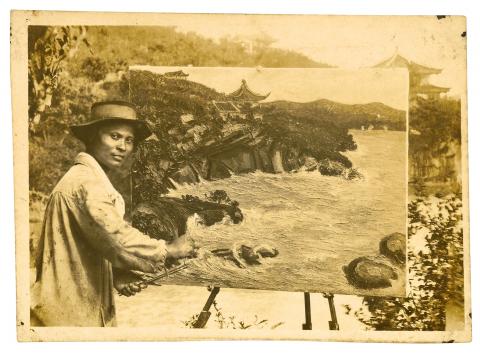
Photo: Tsai Shu-yuan, Taipei Times
“It’s proof,” Chang says. Proof that Chen was killed by government troops in 1947 during an anti-government uprising following the 228 Incident.
Chang reportedly risked her life to collect Chen’s corpse and hired a photographer to take a photo of the body, an image that is now on display at the Chiayi Municipal Museum (嘉義市立博物館).
Chen is one of those figures whose accomplishments were largely erased by politics, and his name, or at least his fate, largely disappeared from public conscious until after the lifting of martial law in 1987.
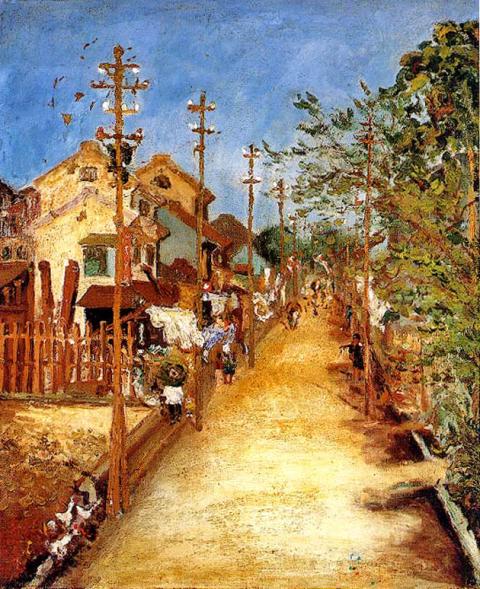
Courtesy of the National Taiwan Museum of Fine Arts
Even the National Central Library, which has in its collection all kinds of old books that would have been considered controversial in the past, has only one item — a collection of his paintings — about Chen dating before 1987.
In the 1997 government-published children’s book, Taiwanese Artist: Chen Cheng-po (台灣美術家: 陳澄波), release two years after former president Lee Teng-hui (李登輝) publicly apologized to 228 victims, author Chen Chang-hua (陳長華) was able to openly mention how the artist died, though she concludes it in one sentence: “In 1947, the 228 Incident happened in Taiwan, and Chen Cheng-po, who was a city councilman, became one of the incident’s unfortunate victims.”
However, in the epilogue, Chen writes, “Chen’s artistic accomplishments were unable to be made public for a long time because of the political shadow of 228. In fact, in this open era, we should revisit Chen’s journey as an artist … to pay him further respect.”
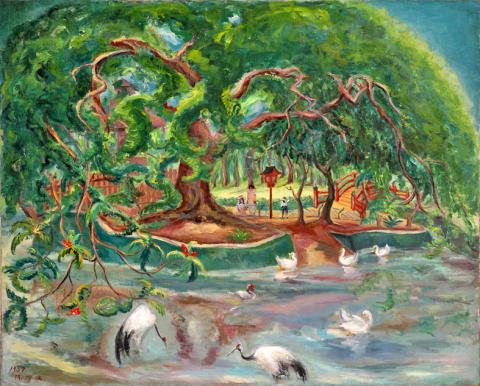
Courtesy of the National Taiwan Museum of Fine Arts
Chen Chang-hua may be right; ever since the public became able to openly discuss Chen Cheng-po, his fate has dominated the discourse. Aside from being a 228 victim and talented artist, what do we really know about Chen?
Born on Feb. 2, 1895 in today’s Chiayi, Chen’s family wasn’t wealthy enough for him to realize his artistic aspirations, and after attending university in Taipei he returned home and taught in public schools in the area for about seven years.
By the time he was accepted to the Tokyo School of Fine Arts (now Tokyo University of the Arts), Chen was nearly 30 years old. In just two years, his oil painting of a street scene in Chiayi was accepted to the annual prestigious Japan Imperial Art Exhibition, and another street scene also made the show the following year. This made Chen the first Taiwanese to have a Western-style painting featured in the exhibition.
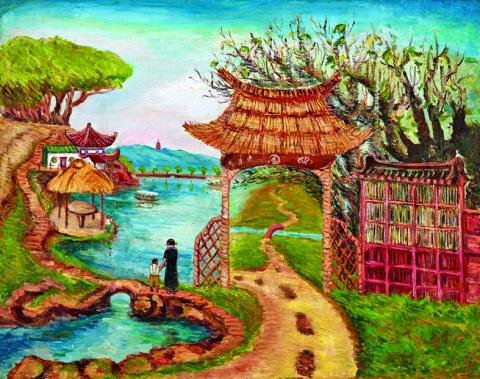
Courtesy of Liang Gallery
Chen graduated in 1929 with a degree in Western art and headed to Shanghai, where he spent four years as an art teacher. While in China, he learned traditional Chinese painting techniques, which he integrated into his techniques.
Japan invaded Shanghai in 1932, and as Japanese citizens, Taiwanese living in China also became the target of anti-Japanese sentiment. Chen returned to Chiayi in 1933 and became a full-time artist. Life wasn’t easy, as he reportedly couldn’t afford his daughter’s dowry and provided two paintings instead.
He’s reported to have said, “As someone whose mission it is to create art, if I can’t live for art and die for art, how can I call myself an artist?”
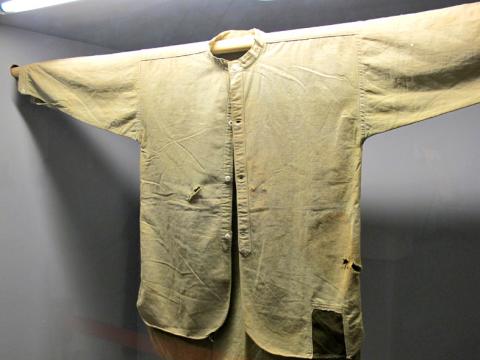
Courtesy of Wikimedia Commons
The Japanese surrendered in 1945. Since Chen learned Mandarin in Shanghai, he took up the position as vice-head of Chiayi’s Preparatory Committee to Welcome the National Government (歡迎國民政府籌備委員會).
This foray into politics would eventually seal his fate. The next year, he joined the Chinese Nationalist Party (KMT) and served in the first Chiayi city council.
Historian Wang Chao-wen (王昭文) writes that when the 228 incident broke out, some of the fiercest fighting between civilians and government troops took place in Chiayi. On March 11, 1947, after a nine-day standoff between the military in the airport and armed civilians, Chen and several other representatives entered the airport in an attempt to negotiate with the government.
The military instead arrested four of the representatives, including Chen, and publicly shot them in front of Chiayi’s train station without a trial on March 25. Chen’s lifeless body lay on the streets of Chiayi, surrounded by scenes that he loved to paint so much, for three days until his wife finally ventured out and collected the corpse.
Taiwan in Time, a column about Taiwan’s history that is published every Sunday, spotlights important or interesting events around the nation that have anniversaries this week.

April 28 to May 4 During the Japanese colonial era, a city’s “first” high school typically served Japanese students, while Taiwanese attended the “second” high school. Only in Taichung was this reversed. That’s because when Taichung First High School opened its doors on May 1, 1915 to serve Taiwanese students who were previously barred from secondary education, it was the only high school in town. Former principal Hideo Azukisawa threatened to quit when the government in 1922 attempted to transfer the “first” designation to a new local high school for Japanese students, leading to this unusual situation. Prior to the Taichung First

Chinese Nationalist Party (KMT) Chairman Eric Chu (朱立倫) hatched a bold plan to charge forward and seize the initiative when he held a protest in front of the Taipei City Prosecutors’ Office. Though risky, because illegal, its success would help tackle at least six problems facing both himself and the KMT. What he did not see coming was Taipei Mayor Chiang Wan-an (將萬安) tripping him up out of the gate. In spite of Chu being the most consequential and successful KMT chairman since the early 2010s — arguably saving the party from financial ruin and restoring its electoral viability —

The Ministry of Education last month proposed a nationwide ban on mobile devices in schools, aiming to curb concerns over student phone addiction. Under the revised regulation, which will take effect in August, teachers and schools will be required to collect mobile devices — including phones, laptops and wearables devices — for safekeeping during school hours, unless they are being used for educational purposes. For Chang Fong-ching (張鳳琴), the ban will have a positive impact. “It’s a good move,” says the professor in the department of
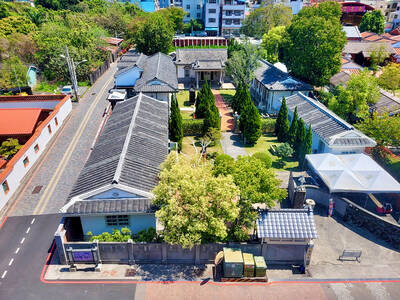
Toward the outside edge of Taichung City, in Wufeng District (霧峰去), sits a sprawling collection of single-story buildings with tiled roofs belonging to the Wufeng Lin (霧峰林家) family, who rose to prominence through success in military, commercial, and artistic endeavors in the 19th century. Most of these buildings have brick walls and tiled roofs in the traditional reddish-brown color, but in the middle is one incongruous property with bright white walls and a black tiled roof: Yipu Garden (頤圃). Purists may scoff at the Japanese-style exterior and its radical departure from the Fujianese architectural style of the surrounding buildings. However, the property